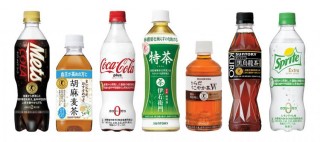Loading
Search
▼ Drink to Your Health: How Japan’s 'Tokuho' Products Took Shape
- Category:Gourmet
TOKYO - Pepsi Light, Diet Coke, and Fanta Zero are just a few of the popular options beverage companies have long offered health-conscious consumers worldwide. But in Japan, another option has surfaced that promises greater health benefits: tokuho.
In 1991, the Ministry of Health, Labour and Welfare (MHLW) introduced tokuho (short for tokutei hoken-yo shokuhin) as a label for food and drinks with health qualities. These are identified by the MHLW as foods for specified health use (FOSHU).
The FOSHU label was initially introduced to make sense of the increasingly saturated health-food market, providing a way to measure the effectiveness and legitimacy of a product’s claimed benefits.
Since then, a variety of tokuho beverages—including teas, juices, and carbonated drinks—have found their way onto the shelves of convenience stores and supermarkets across Japan, and the trend shows no sign of waning.
Coca-Cola (Japan) Co., Ltd., Kirin Beverage Company Limited, and Suntory Beverage and Food Limited are just three giants that have introduced tokuho drinks, adding to broad caches of products designed to meet the demands of health-focused Japanese consumers.
THE PROCESS
Tokuho products require years of research, clinical testing and trials, and government approval before they can qualify for the label. FOSHU approval means that the effect on the human body is clearly proven, there are no safety issues, nutritionally appropriate ingredients are used, and established quality control methods are carried out.
In addition to the normal products, there are three further types: qualified, standardized, and reduction of disease risk. All products looking to carry this label must go through the Consumer Affairs Agency (CAA), the MHLW, the Pharmaceutical Affairs and Food Sanitation Council, and the Food Safety Commission.
“Unfortunately, it costs a lot to get approval from the government,” explained Dr. Harunobu Amagase, chair of the Dietary Supplements Committee at the American Chamber of Commerce in Japan (ACCJ).
In 1991, the Ministry of Health, Labour and Welfare (MHLW) introduced tokuho (short for tokutei hoken-yo shokuhin) as a label for food and drinks with health qualities. These are identified by the MHLW as foods for specified health use (FOSHU).
The FOSHU label was initially introduced to make sense of the increasingly saturated health-food market, providing a way to measure the effectiveness and legitimacy of a product’s claimed benefits.
Since then, a variety of tokuho beverages—including teas, juices, and carbonated drinks—have found their way onto the shelves of convenience stores and supermarkets across Japan, and the trend shows no sign of waning.
Coca-Cola (Japan) Co., Ltd., Kirin Beverage Company Limited, and Suntory Beverage and Food Limited are just three giants that have introduced tokuho drinks, adding to broad caches of products designed to meet the demands of health-focused Japanese consumers.
THE PROCESS
Tokuho products require years of research, clinical testing and trials, and government approval before they can qualify for the label. FOSHU approval means that the effect on the human body is clearly proven, there are no safety issues, nutritionally appropriate ingredients are used, and established quality control methods are carried out.
In addition to the normal products, there are three further types: qualified, standardized, and reduction of disease risk. All products looking to carry this label must go through the Consumer Affairs Agency (CAA), the MHLW, the Pharmaceutical Affairs and Food Sanitation Council, and the Food Safety Commission.
“Unfortunately, it costs a lot to get approval from the government,” explained Dr. Harunobu Amagase, chair of the Dietary Supplements Committee at the American Chamber of Commerce in Japan (ACCJ).
“You have to prepare all the dossier, including safety information, exposure history, the quality control system and, most importantly, a finished product clinical study in randomized clinical trial. You have to do a clinical study on the finished product even if the main components and excipients [or inactive substances] have been approved before.”
This means a company could create a product and see it be turned down at the final hurdle, resulting in a lot of wasted time and money.
“That’s why only big companies can apply or try to get approval, and that’s a disadvantage,” Amagase added, meaning smaller companies can’t compete.
Kirin was the first to create a tokuho soda—Kirin Mets Cola—which contains indigestible dextrin, suppressing the absorption of fat and making the rise of blood neutral fat gentle.
“Since launching in April 2012, the target has been cola drinkers who are beginning to worry about over-thirties health,” a Kirin spokesperson told
The ACCJ Journal. “As the first cola-type beverage, we acquired the image ‘looks good for health,’ and this has led the cola category of food for specified health use.”
Suntory also entered the market with Kuro Oolong Tea, which contains oolong tea polymerized polyphenols, and Goma Mugicha (sesame barley tea), which is said to lower blood pressure thanks to sesame peptide.
With this, Suntory took one step further in their tokuho business strategy and, according to a May 28, 2015, Nikkei Asian Review article, opened
The World Research Center. This global research and development base in Kyoto nurtures research and development of health-related food and beverages, including tokuho drinks.
Coca-Cola is reaping the benefits of FOSHU beverages, too. To begin, the global brand did not go for what those outside Japan might see as obvious—carbonated drinks—instead introducing Karada Sukoyakacha W, the first FOSHU beverage approved by the CAA as having the effects of both moderating the absorption of carbohydrates and controlling the absorption of fat. Like Mets Cola, the tea contains indigestible dextrin to prevent fat absorption and moderate the absorption of carbohydrates.
“After several innovations, through which our knowledge of and technology in product development had been refined, we introduced the bestseller FOSHU Karada Sukoyakacha W in 2014, followed by Coca-Cola Plus and Sprite Extra, which were launched in 2017,” a spokesperson for Coca-Cola Japan told The ACCJ Journal.
“There is a common element of tokuho products in which we take pride: great taste. We consider that consumers value and savor the beverages on top of their functionality, therefore our tokuho products are approved by consumers and are doing well so far.”
Most items contain similar ingredients such as indigestible, soluble dietary fiber. “This is because it is safe and approved by the government,” Amagase explained. This means a relatively easier approval process requiring less money, but also dampens innovation.
THE HEALTH FACTOR
Increasing concerns over everyday diet and health has driven demand for tokuho products. In fact, Kirin presumes that health consciousness is increasing every year, and this not only creates a market for FOSHU but also for foods with function claims (FCC) a new category added on April 1, 2015.
A spokesperson for Suntory Beverage and Food Limited, added that the value Japanese society places on a balanced diet also plays a part in the success of tokuho drinks. “There is a Japanese saying, ‘ishokudougen,’ which means a balanced diet leads to a healthy body. As you can see from this saying, Japanese people value a balanced diet for their healthy life.
We think this kind of attitude can be a factor of its popularity.”
One concern Kirin highlighted is metabolic syndrome, a term used for a cluster of conditions, such as high blood pressure, higher blood sugar, excess fat around the waist, and high cholesterol that, together, can increase the risk of diabetes, heart disease, stroke, and other problems.
This means a company could create a product and see it be turned down at the final hurdle, resulting in a lot of wasted time and money.
“That’s why only big companies can apply or try to get approval, and that’s a disadvantage,” Amagase added, meaning smaller companies can’t compete.
Kirin was the first to create a tokuho soda—Kirin Mets Cola—which contains indigestible dextrin, suppressing the absorption of fat and making the rise of blood neutral fat gentle.
“Since launching in April 2012, the target has been cola drinkers who are beginning to worry about over-thirties health,” a Kirin spokesperson told
The ACCJ Journal. “As the first cola-type beverage, we acquired the image ‘looks good for health,’ and this has led the cola category of food for specified health use.”
Suntory also entered the market with Kuro Oolong Tea, which contains oolong tea polymerized polyphenols, and Goma Mugicha (sesame barley tea), which is said to lower blood pressure thanks to sesame peptide.
With this, Suntory took one step further in their tokuho business strategy and, according to a May 28, 2015, Nikkei Asian Review article, opened
The World Research Center. This global research and development base in Kyoto nurtures research and development of health-related food and beverages, including tokuho drinks.
Coca-Cola is reaping the benefits of FOSHU beverages, too. To begin, the global brand did not go for what those outside Japan might see as obvious—carbonated drinks—instead introducing Karada Sukoyakacha W, the first FOSHU beverage approved by the CAA as having the effects of both moderating the absorption of carbohydrates and controlling the absorption of fat. Like Mets Cola, the tea contains indigestible dextrin to prevent fat absorption and moderate the absorption of carbohydrates.
“After several innovations, through which our knowledge of and technology in product development had been refined, we introduced the bestseller FOSHU Karada Sukoyakacha W in 2014, followed by Coca-Cola Plus and Sprite Extra, which were launched in 2017,” a spokesperson for Coca-Cola Japan told The ACCJ Journal.
“There is a common element of tokuho products in which we take pride: great taste. We consider that consumers value and savor the beverages on top of their functionality, therefore our tokuho products are approved by consumers and are doing well so far.”
Most items contain similar ingredients such as indigestible, soluble dietary fiber. “This is because it is safe and approved by the government,” Amagase explained. This means a relatively easier approval process requiring less money, but also dampens innovation.
THE HEALTH FACTOR
Increasing concerns over everyday diet and health has driven demand for tokuho products. In fact, Kirin presumes that health consciousness is increasing every year, and this not only creates a market for FOSHU but also for foods with function claims (FCC) a new category added on April 1, 2015.
A spokesperson for Suntory Beverage and Food Limited, added that the value Japanese society places on a balanced diet also plays a part in the success of tokuho drinks. “There is a Japanese saying, ‘ishokudougen,’ which means a balanced diet leads to a healthy body. As you can see from this saying, Japanese people value a balanced diet for their healthy life.
We think this kind of attitude can be a factor of its popularity.”
One concern Kirin highlighted is metabolic syndrome, a term used for a cluster of conditions, such as high blood pressure, higher blood sugar, excess fat around the waist, and high cholesterol that, together, can increase the risk of diabetes, heart disease, stroke, and other problems.
The number of people diagnosed annually with metabolic syndrome in Japan has been rising since 2005, resulting in a tendency toward health consciousness among the population. “Under such circumstances,” speculates Kirin, “popularity has increased for beverages [labeled] as FOSHU.”
However, Amagase notes that industry interest in and applications for FOSHU are declining. On the other hand, with more than 1,000 accepted applications, FFC has exceeded FOSHU in just a little more than two years.
FURTHER THAN JAPAN
When asked why the tokuho label has not been introduced elsewhere in the world, a Coca-Cola Japan spokesperson explained that it is largely because the system is endemic to Japan. “The tokuho system, led by the Japanese government, is proper to this country, and the tokuho business grew in accordance with government policy.”
This difference in market is also evident in Coca-Cola’s products, such as Aquarius, Georgia coffee, and Sokenbicha, a blend of 12 ingredients that has become one of the best-selling teas in Japan since its introduction in 1993. All of these drinks were developed for the Japanese market, meaning some are less appealing to other markets.
Kirin’s spokesperson added that the certification system for active ingredients differs for each country, therefore they are not considering developing anything overseas. However, Kirin sees great value in these drinks, and they fit within the rest of its product line in Japan.
According to the Coca-Cola website, Japan is considered one of the company’s fastest-moving and inventive markets, with the Japanese business unit releasing about 100 new products in 2016 alone. The growth of these drinks looks to continue—especially as health concerns rise. Kirin added that Japan’s aging society does seem to be affecting medical expenses, as causing society to pay closer attention to health.
In Amagase’s opinion, “FOSHU will stay around because, in Japan, they don’t terminate those systems immediately. They continue to exist and, if no applications are made for, let’s say, 10 years, then they disappear naturally.”
Amagase added that the market for such health-related products in Japan is lagging behind the US. According to the ACCJ–EBC Health Policy White Paper 2017 (page 15), the size of the US market in 2012 was $32.5 billion while the Japanese market was only $8 billion. He said that, to meet the demands of an aging society, this must be addressed, as Japanese exports are currently at a disadvantage.
The white paper also recommends deregulation to ease the approval system. The FFC system was initially modeled after the US dietary supplement regulatory system, a notification system in which the industry should only notify regulators before the new functional claims are made.
However, the FFC system has become one in which the CAA insists on reviewing and evaluating application dossiers submitted for each product by each company.
In addition, the white paper includes a recommendation to further innovation by revising the list of foods recognized as pharmaceuticals so that it is aligned with global standards.
Overall, this should relieve demands on Japan’s public and private insurance systems and medical services. “It is very beneficial to consumers,” Amagase concluded, “but, due to the regulatory system in Japan, it’s not so easy to promote those kinds of products with the appropriate functional claim.”
However, Amagase notes that industry interest in and applications for FOSHU are declining. On the other hand, with more than 1,000 accepted applications, FFC has exceeded FOSHU in just a little more than two years.
FURTHER THAN JAPAN
When asked why the tokuho label has not been introduced elsewhere in the world, a Coca-Cola Japan spokesperson explained that it is largely because the system is endemic to Japan. “The tokuho system, led by the Japanese government, is proper to this country, and the tokuho business grew in accordance with government policy.”
This difference in market is also evident in Coca-Cola’s products, such as Aquarius, Georgia coffee, and Sokenbicha, a blend of 12 ingredients that has become one of the best-selling teas in Japan since its introduction in 1993. All of these drinks were developed for the Japanese market, meaning some are less appealing to other markets.
Kirin’s spokesperson added that the certification system for active ingredients differs for each country, therefore they are not considering developing anything overseas. However, Kirin sees great value in these drinks, and they fit within the rest of its product line in Japan.
According to the Coca-Cola website, Japan is considered one of the company’s fastest-moving and inventive markets, with the Japanese business unit releasing about 100 new products in 2016 alone. The growth of these drinks looks to continue—especially as health concerns rise. Kirin added that Japan’s aging society does seem to be affecting medical expenses, as causing society to pay closer attention to health.
In Amagase’s opinion, “FOSHU will stay around because, in Japan, they don’t terminate those systems immediately. They continue to exist and, if no applications are made for, let’s say, 10 years, then they disappear naturally.”
Amagase added that the market for such health-related products in Japan is lagging behind the US. According to the ACCJ–EBC Health Policy White Paper 2017 (page 15), the size of the US market in 2012 was $32.5 billion while the Japanese market was only $8 billion. He said that, to meet the demands of an aging society, this must be addressed, as Japanese exports are currently at a disadvantage.
The white paper also recommends deregulation to ease the approval system. The FFC system was initially modeled after the US dietary supplement regulatory system, a notification system in which the industry should only notify regulators before the new functional claims are made.
However, the FFC system has become one in which the CAA insists on reviewing and evaluating application dossiers submitted for each product by each company.
In addition, the white paper includes a recommendation to further innovation by revising the list of foods recognized as pharmaceuticals so that it is aligned with global standards.
Overall, this should relieve demands on Japan’s public and private insurance systems and medical services. “It is very beneficial to consumers,” Amagase concluded, “but, due to the regulatory system in Japan, it’s not so easy to promote those kinds of products with the appropriate functional claim.”
- October 10, 2017
- Comment (0)
- Trackback(0)




